The Development of Autonomous Student Learning Networks: Patterns of Interactions in an Open World Learning Environment for Teachers Exploring Teaching with and through Computer Science
Abstract
:1. Introduction
- What patterns of connections and interactions emerge between students and their instructor in a graduate teacher education course designed using elements of open world game design?
- In what ways does the degree of autonomy designed into key learning activities influence the types and patterns of interactions between the students with one another and their instructor?
2. Review of the Related Literature
2.1. Motivation and Engagement—Self-Determination Theory
Several important conclusions can be drawn from these and related findings on intrinsic motivation. First, both teachers’ orientations and specific aspects of learning tasks that are perceived as autonomy supportive are conducive to students’ intrinsic motivation, whereas controlling educational climates undermine intrinsic motivation. Second, students tend to learn better and are more creative when intrinsically motivated, particularly on tasks requiring conceptual understanding. Third, the way in which teachers introduce learning tasks impacts students’ satisfaction of the basic psychological needs for autonomy and competence, thereby either allowing intrinsic motivation to flourish and deeper learning to occur or thwarting those processes. [19] (p. 136).
2.2. Game Design and Instructional Design
3. Materials and Methods
3.1. Context and Participants
3.2. Course Design as Game Design
Learning Design
- Focused and clear learning goals: Before starting each activity in the course (see Table 1), students were informed of the learning goals and expectations. The main purpose of the gameplay is usually entertainment (especially when commercial games are used for educational purposes), so in order to receive maximum educational benefits, the instructor clearly explained how the games will be used in the course and how it will benefit the learners. At the end of the study, an alignment between learning objectives and outcomes was carefully established.
- Setting and Actions: In a successful learning design, learners are informed of the characters in the game, its settings, environmental dimensions such as geography, historical context, and appearance. The instructor of the course provided this information to the students in advance so they would not lose focus or become distracted while searching for information.
- Instructional Support: The role of the instructor was an important variable in the present study, so special attention was paid to when and how the instructor interfered in the gaming activities. An initial explanation and orientation by the instructor was followed by student-centered gaming activities.
- Learner autonomy: When it comes to learning design for game-based learning, “the learner plays an active role in the construction of knowledge, while the role of the teacher is to provide materials and an environment that support the learner’s engagement in the learning tasks” (Dickey, 2005, p. 78). In our design, students actively engaged in the gaming activities and the course instructor only guided them while they were involved in the gameplay. Students were given opportunities to discover the game among themselves with no instructor interference. This approach resulted in a high level of collaboration, with students giving each other feedback and discussing issues they faced in the game environment in a more active and engaged way.
3.3. Data Collection and Analysis
3.3.1. Student/Instructor Interaction Data
3.3.2. Data Analysis—Social Network Analysis
3.3.3. Data Analysis—Epistemic Network Analysis
4. Results
4.1. Patterns of Course Interactions
Emergent Social Networks
4.2. Content of Course Interactions
Epistemic Spaces
5. Discussion
5.1. Limitation of the Study
5.2. Implications and Further Research
Author Contributions
Funding
Institutional Review Board Statement
Informed Consent Statement
Acknowledgments
Conflicts of Interest
References
- Salen, K.; Tekinbaş, K.S.; Zimmerman, E. Rules of Play: Game Design Fundamentals; MIT Press: Cambridge, MA, USA, 2004. [Google Scholar]
- Kapp, K.M. The Gamification of Learning and Instruction: Game-Based Methods and Strategies for Training and Education; John Wiley & Sons: Hoboken, NJ, USA, 2004. [Google Scholar]
- Kim, S.; Song, K.; Lockee, B.; Burton, J. What is gamification in learning and education? In Gamification in Learning and Education; Springer: Cham, Switzerland, 2018; pp. 25–38. [Google Scholar]
- Kelly, K.A. A yearlong general education course using “Reacting to the Past” pedagogy to explore democratic practice. Int. J. Learn. 2009, 16, 147–155. [Google Scholar] [CrossRef]
- Good, B.M.; Su, A.I. Games with a scientific purpose. Genome Biol. 2011, 12, 135. [Google Scholar] [CrossRef]
- Uysal, A.; Yildirim, I.G. Self-determination theory in digital games. In Gamer Psychology and Behavior; Bostan, B., Ed.; Springer: Cham, Switzerland, 2016; pp. 123–135. [Google Scholar]
- Gee, J.P. Games, learning and 21st century survival skills. J. For. Virtual Worlds Res. 2009, 2. [Google Scholar] [CrossRef]
- Proulx, J.N.; Romero, M.; Arnab, S. Learning mechanics and game mechanics under the perspective of self-determination theory to foster motivation in digital game-based learning. Simul. Gaming 2017, 48, 81–97. [Google Scholar] [CrossRef]
- Ryan, R.M.; Deci, E.L. Self-determination theory and the facilitation of intrinsic motivation, social development and well-being. Am. Psychol. 2000, 55, 68–77. [Google Scholar] [CrossRef]
- Chen, B.; Vansteenkiste, M.; Beyers, W.; Boone, L.; Deci, E.L.; Van der Kaap-Deeder, J.; Duriez, B.; Lens, W.; Matos, L.; Mouratidis, A.; et al. Basic psychological need satisfaction, need frustration, and need strength across four cultures. Motiv. Emot. 2015, 39, 216–236. [Google Scholar] [CrossRef]
- Vansteenkiste, M.; Ryan, R.M.; Soenens, B. Basic psychological need theory: Advancements, critical themes and future directions. Motiv. Emot. 2020, 44, 1–31. [Google Scholar] [CrossRef] [Green Version]
- Wannheden, C.; Stenfors, T.; Stenling, A.; von Thiele Schwarz, U. Satisfied or frustrated? A qualitative analysis of need satisfying and need frustrating experiences of engaging with digital health technology in chronic care. Front. Public Health 2021, 8, 1097. [Google Scholar] [CrossRef]
- Levesque-Côté, J.; Fernet, C.; Morin, A.J.; Austin, S. On the motivational nature of authentic leadership practices: A latent profile analysis based on self-determination theory. Leadersh. Organ. Dev. J. 2020, 42, 178–194. [Google Scholar] [CrossRef]
- Sheldon, K.M. Catholic guilt? comparing catholics’ and protestants’ religious motivations. Int. J. Psychol. Relig. 2006, 216, 209–223. [Google Scholar] [CrossRef]
- Jeno, L.M.; Vandvik, V.; Eliassen, S.; Grytnes, J.A. Testing the novelty effect of an m-learning tool on internalization and achievement: A self-determination theory approach. Comput. Educ. 2019, 128, 398–413. [Google Scholar] [CrossRef]
- Howard, J.L.; Bureau, J.S.; Guay, F.; Chong, J.X.Y.; Ryan, R.M. Student motivation and associated outcomes: A meta-analysis from self-determination theory. Perspect. Psychol. Sci. 2021. [Google Scholar] [CrossRef]
- Taylor, G.; Jungert, T.; Mageau, G.A.; Schattke, K.; Dedic, H.; Rosenfield, S.; Koestner, R. A self-determination theory approach to predicting school achievement over time: The unique role of intrinsic motivation. Contemp. Educ. Psychol. 2014, 39, 342–358. [Google Scholar] [CrossRef]
- Wang, C.J.; Liu, W.C.; Kee, Y.H.; Chian, L.K. Competence; autonomy, and relatedness in the classroom: Understanding students’ motivational processes using the self-determination theory. Heliyon 2019, 5, e01983. [Google Scholar] [CrossRef] [Green Version]
- Niemiec, C.P.; Ryan, R.M. Autonomy, competence, and relatedness in the classroom: Applying self-determination theory to educational practice. Theory Res. Educ. 2009, 7, 133–144. [Google Scholar] [CrossRef]
- Rigby, C.S.; Ryan, R.M. Glued to Games: How Video Games Draw Us in and Hold Us Spellbound; Praeger: Santa Barbara, CA, USA, 2011. [Google Scholar]
- Peng, W.; Lin, J.; Pfeiffer, K.; Winn, B. Need satisfaction supportive game features as motivational determinants: An experimental study of a self-determination theory guided exergame. Media Psychol. 2012, 15, 175–196. [Google Scholar] [CrossRef]
- Ryan, R.M.; Rigby, C.S.; Przybylski, A. The motivational pull of video games: A self-determination theory approach. Motiv. Emot. 2006, 30, 344–360. [Google Scholar] [CrossRef]
- Arnab, S.; Lim, T.; Carvalho, M.B.; Bellotti, F.; De Freitas, S.; Louchart, S.; Suttie, N.; Berta, R.; De Gloria, A. Mapping learning and game mechanics for serious games analysis. Br. J. Educ. Technol. 2015, 46, 391–411. [Google Scholar] [CrossRef] [Green Version]
- Kemp, J.E.; Morrison, G.R.; Ross, S.M. Designing Effective Instruction, 7th ed.; John Wiley & Sons: Hoboken, NJ, USA, 2012. [Google Scholar]
- White, N. Gamification, an Instructional Strategy to Course Design and Impact on Learning Outcomes. Ph.D. Thesis, Capella University, Minneapolis, MN, USA, 2020. [Google Scholar]
- Wardaszko, M.; Podgórski, B. Mobile learning game effectiveness in cognitive learning by adults: A comparative study. Simul. Gaming 2017, 48, 435–454. [Google Scholar] [CrossRef]
- Bonde, M.T.; Makransky, G.; Wandall, J.; Larsen, M.V.; Morsing, M.; Jarmer, H.; Sommer, M.O.A. Improving biotech education through gamified laboratory simulations. Nat. Biotechnol. 2014, 32, 694–697. [Google Scholar] [CrossRef] [Green Version]
- Koivisto, J.; Hamari, J. The rise of motivational information systems: A review of gamification research. Int. J. Inf. Manag. 2019, 45, 191–210. [Google Scholar] [CrossRef]
- Korte, G.; Ferri, G. Research through game design: Interactive stories from a submerged Amsterdam. Ocula 2018, 19, 110–128. [Google Scholar] [CrossRef]
- Garcia, A. Inform, perform, transform: Modeling in-school youth participatory action research through gameplay. Knowl. Quest 2012, 41, 46. [Google Scholar]
- Walsh, C. Systems-based literacy practices: Digital games research, gameplay and design. Aust. J. Lang. Lit. 2010, 33, 24–40. [Google Scholar]
- Dron, J.; Ostashewski, N. Seeking connectivist freedom and instructivist safety in a mooc. Educación XX1 2015, 18, 51–76. [Google Scholar] [CrossRef] [Green Version]
- Bayliss, J.D.; Schwartz, D.I. Instructional design as game design. In Proceedings of the 4th International Conference on Foundations of Digital Games, New York, NY, USA, 26–30 April 2009; pp. 10–17. [Google Scholar]
- Borgatti, S.P.; Mehra, A.; Brass, D.J.; Labianca, G. Network analysis in the social sciences. Science 2009, 323, 892–895. [Google Scholar] [CrossRef] [Green Version]
- Granovetter, M. The strength of weak ties: A network theory revisited. Sociol. Theory 1983, 1, 201–233. [Google Scholar] [CrossRef]
- Canossa, A.; Harteveld, C. Social network analysis applied to game communities to identify key social players. In Data Analytics Applications in Gaming and Entertainment; CRC Press: Boca Raton, FL, USA, 2019; pp. 169–182. [Google Scholar]
- Pirker, J.; Rattinger, A.; Drachen, A.; Sifa, R. Analyzing player networks in Destiny. Entertain. Comput. 2018, 25, 71–83. [Google Scholar] [CrossRef]
- Amrit, C.; ter Maat, J. Understanding information centrality metric: A simulation approach. arXiv 2018, arXiv:1812.01292. [Google Scholar]
- Fruchterman, T.M.J.; Reingold, E.M. Graph drawing by force-directed placement. Softw. Pract. Exp. 1991, 21, 1129–1164. [Google Scholar] [CrossRef]
- Kalamaras, D. Social Network Visualizer (SocNetV). Available online: http://socnetv.sourceforge.net (accessed on 1 June 2021).
- Corbin, J.; Strauss, A. Basics of Qualitative Research: Techniques and Procedures for Developing Grounded Theory; Sage Publishing: Thousand Oaks, CA, USA, 2014. [Google Scholar]
- Shaffer, D.W. Quantitative Ethnography; Cathcart Press: Madison, WI, USA, 2017. [Google Scholar]
- Shaffer, D.W. Epistemic network analysis: Understanding learning by using big data for thick description. In International Handbook of the Learning Sciences; Fischer, F., Hmelo-Silver, C.E., Goldman, S.R., Reimann, P., Eds.; Routledge: New York, NY, USA, 2018; pp. 520–531. [Google Scholar]
- Vujovic, M.; Amarasinghe, I.; Hernández-Leo, D. Studying collaboration dynamics in physical learning spaces: Considering the temporal perspective through epistemic network analysis. Sensors 2021, 21, 2898. [Google Scholar] [CrossRef]
- Bressler, D.M.; Bodzin, A.M.; Eagan, B.; Tabatabai, S. Using epistemic network analysis to examine discourse and scientific practice during a collaborative game. J. Sci. Educ. Technol. 2019, 28, 553–566. [Google Scholar] [CrossRef]
- Ducheneaut, N.; Yee, N.; Nickell, E.; Moore, R.J. “Alone together?” Exploring the social dynamics of massively multiplayer online games. In Proceedings of the SIGCHI Conference on Human Factors in Computing Systems, Montreal, QC, Canada, 22–26 April 2006; pp. 407–416. [Google Scholar]
- Hamari, J.; Keronen, L. Why do people play games? A meta-analysis. Int. J. Inf. Manag. 2017, 37, 125–141. [Google Scholar] [CrossRef]
- Hsiao, C.C.; Chiou, J.S. The effects of a player’s network centrality on resource accessibility, game enjoyment, and continuance intention: A study on online gaming communities. Electron. Commer. Res. Appl. 2012, 11, 75–84. [Google Scholar] [CrossRef]
- Williams, D.; Ducheneaut, N.; Xiong, L.; Zhang, Y.; Yee, N.; Nickell, E. From tree house to barracks: The social life of guilds in World of Warcraft. Games Cult. 2006, 1, 338–361. [Google Scholar] [CrossRef] [Green Version]
- Van de Bovenkamp, R.; Shen, S.; Jia, A.L.; Kuipers, F. Analyzing implicit social networks in multiplayer online games. IEEE Internet Comput. 2014, 18, 36–44. [Google Scholar]
- Bettinger, E.; Liu, J.; Loeb, S. Connections matter: How interactive peers affect students in online college courses. J. Policy Anal. Manag. 2016, 35, 932–954. [Google Scholar] [CrossRef]
- Martin, F.; Bolliger, D.U. Engagement matters: Student perceptions on the importance of engagement strategies in the online learning environment. Online Learn. 2018, 22, 205–222. [Google Scholar] [CrossRef]
- Truhlar, A.M.; Walter, M.T.; Williams, K.M. Student engagement with course content and peers in synchronous online discussions. Online Learn. 2018, 22, 289–312. [Google Scholar] [CrossRef] [Green Version]
- Richardson, J.C.; Maeda, Y.; Lv, J.; Caskurlu, S. Social presence in relation to students’ satisfaction and learning in the online environment: A meta-analysis. Comput. Hum. Behav. 2017, 71, 402–417. [Google Scholar] [CrossRef]
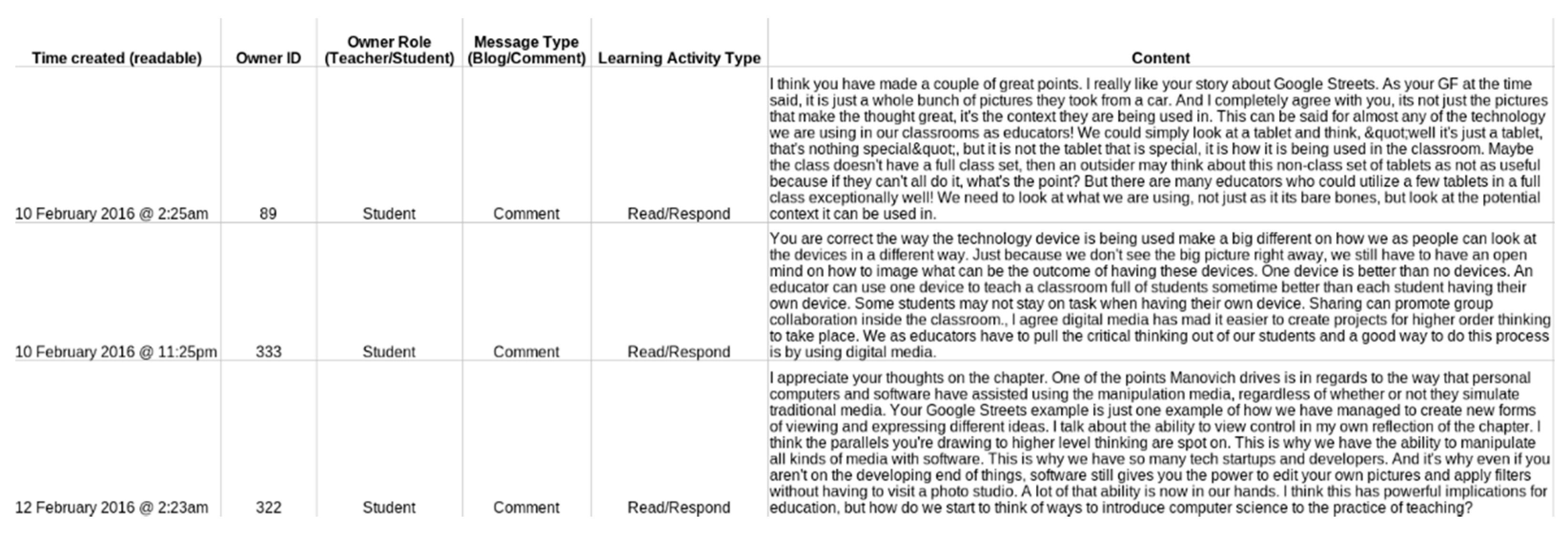
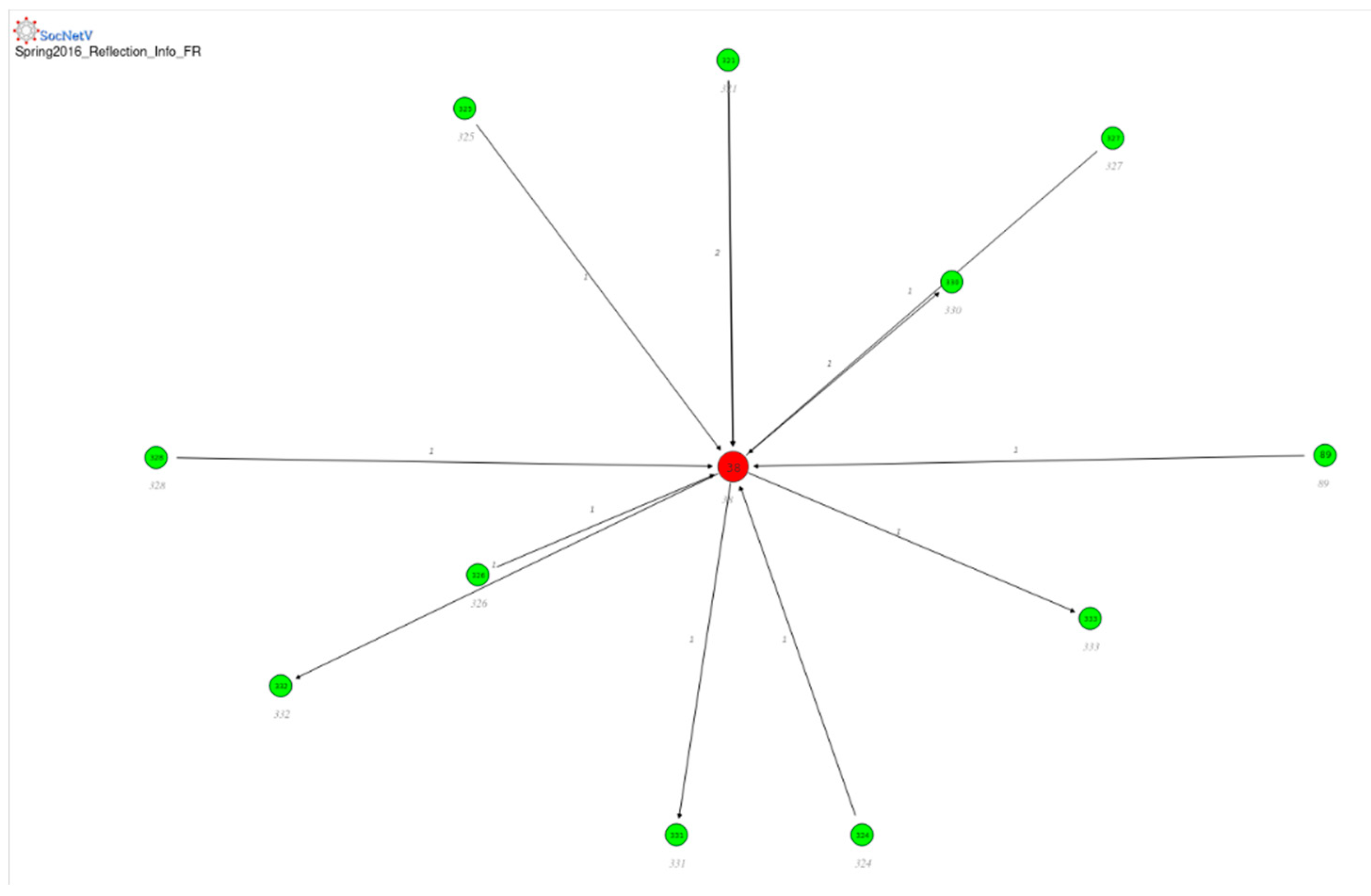

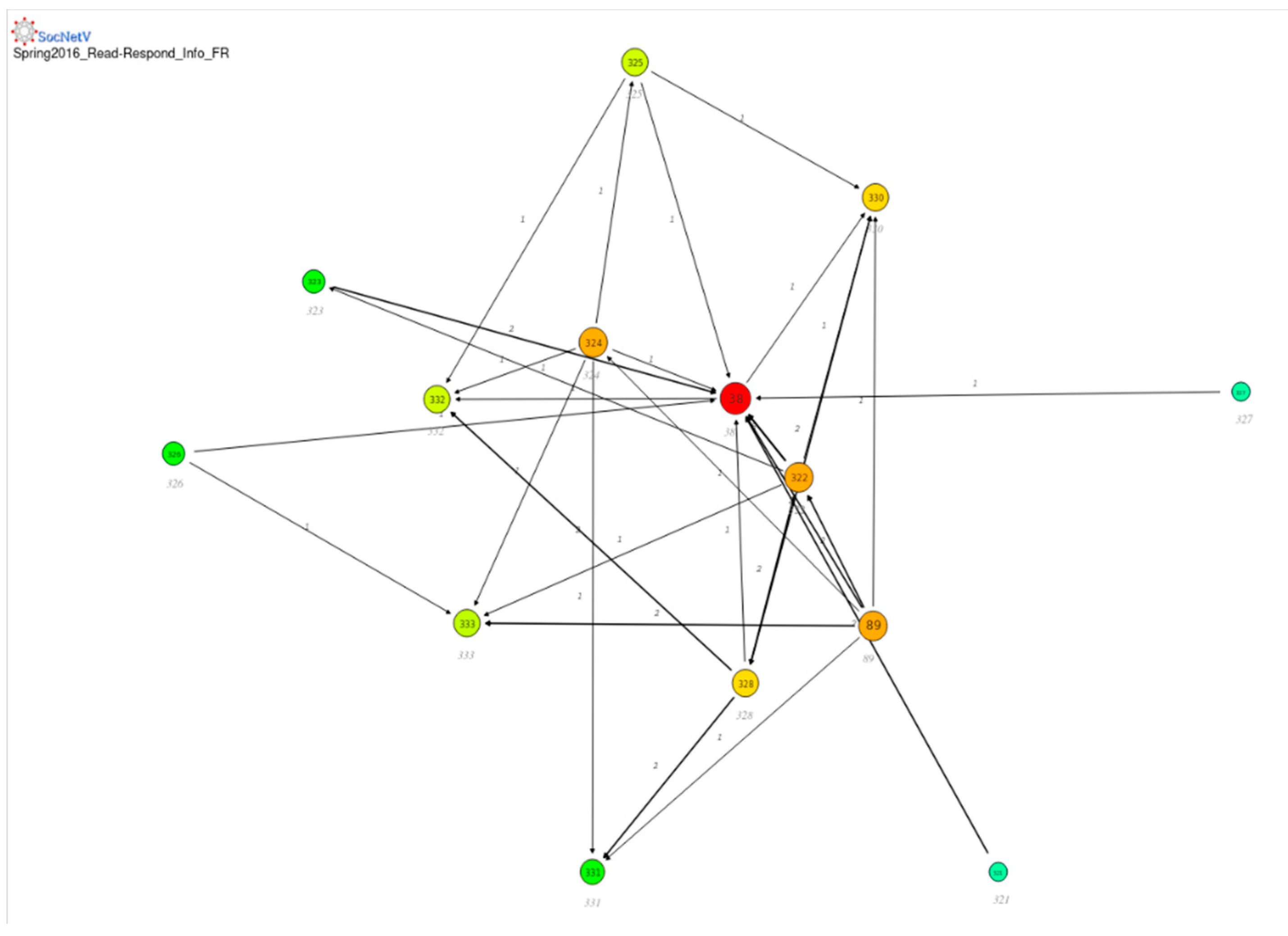

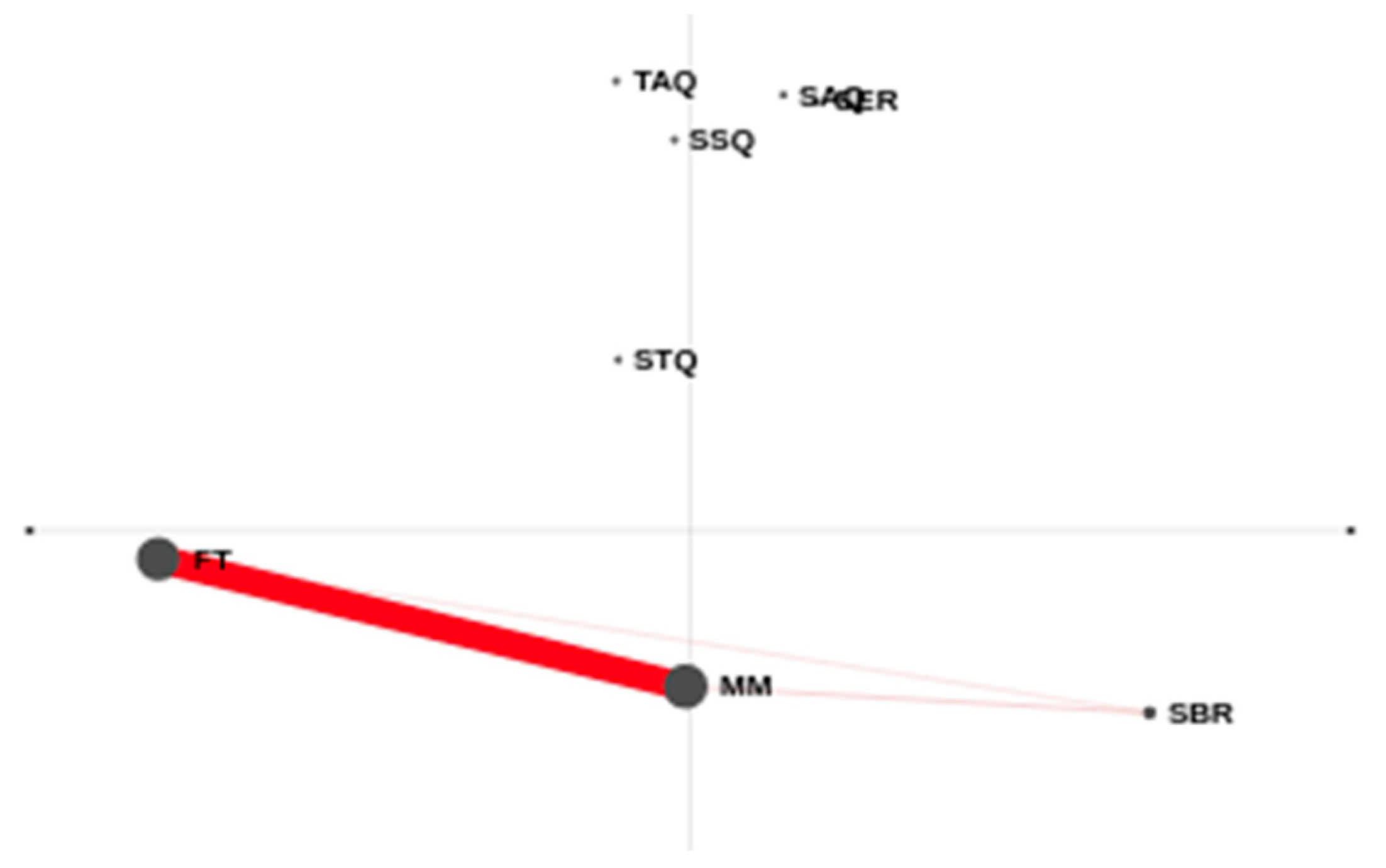

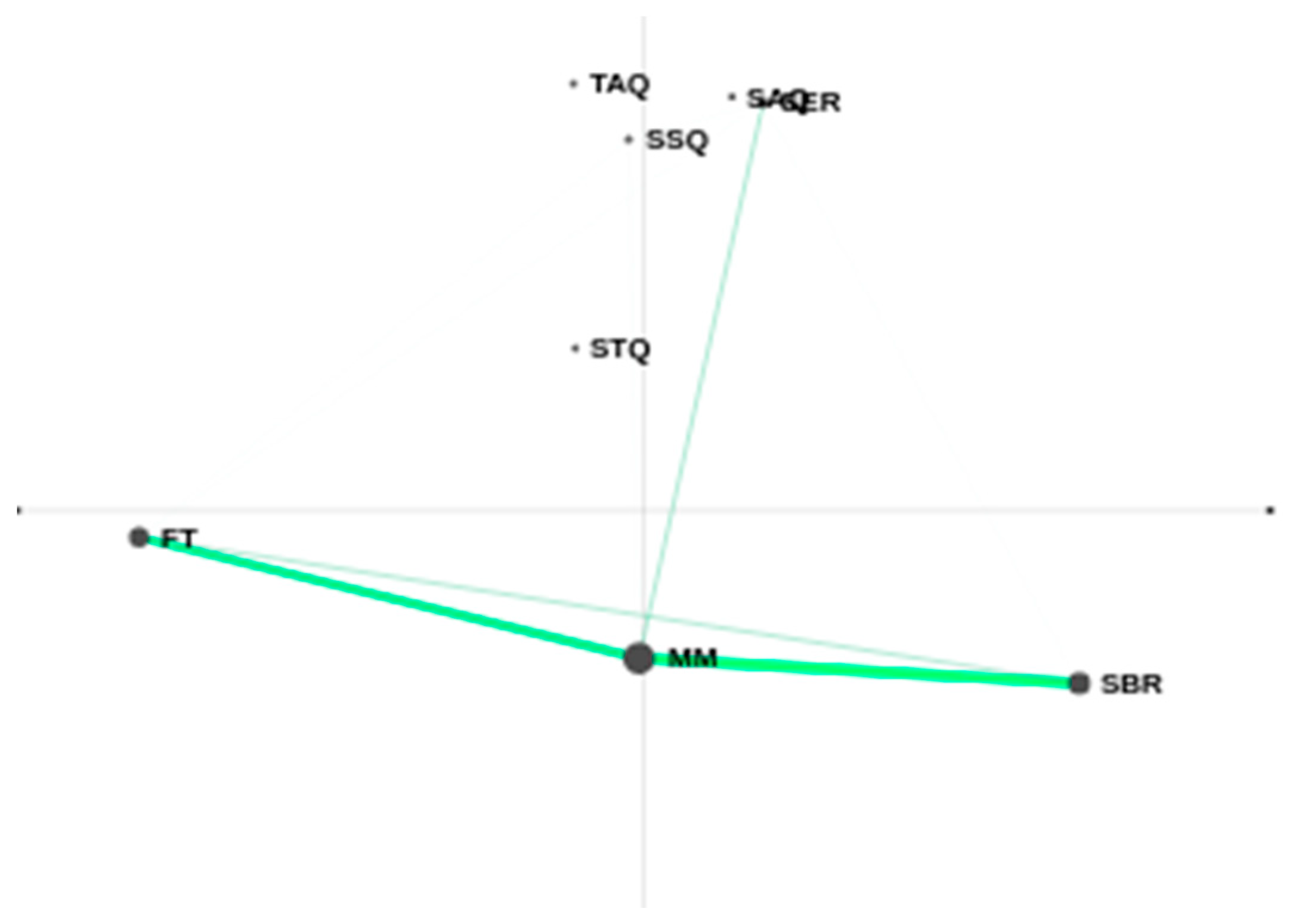
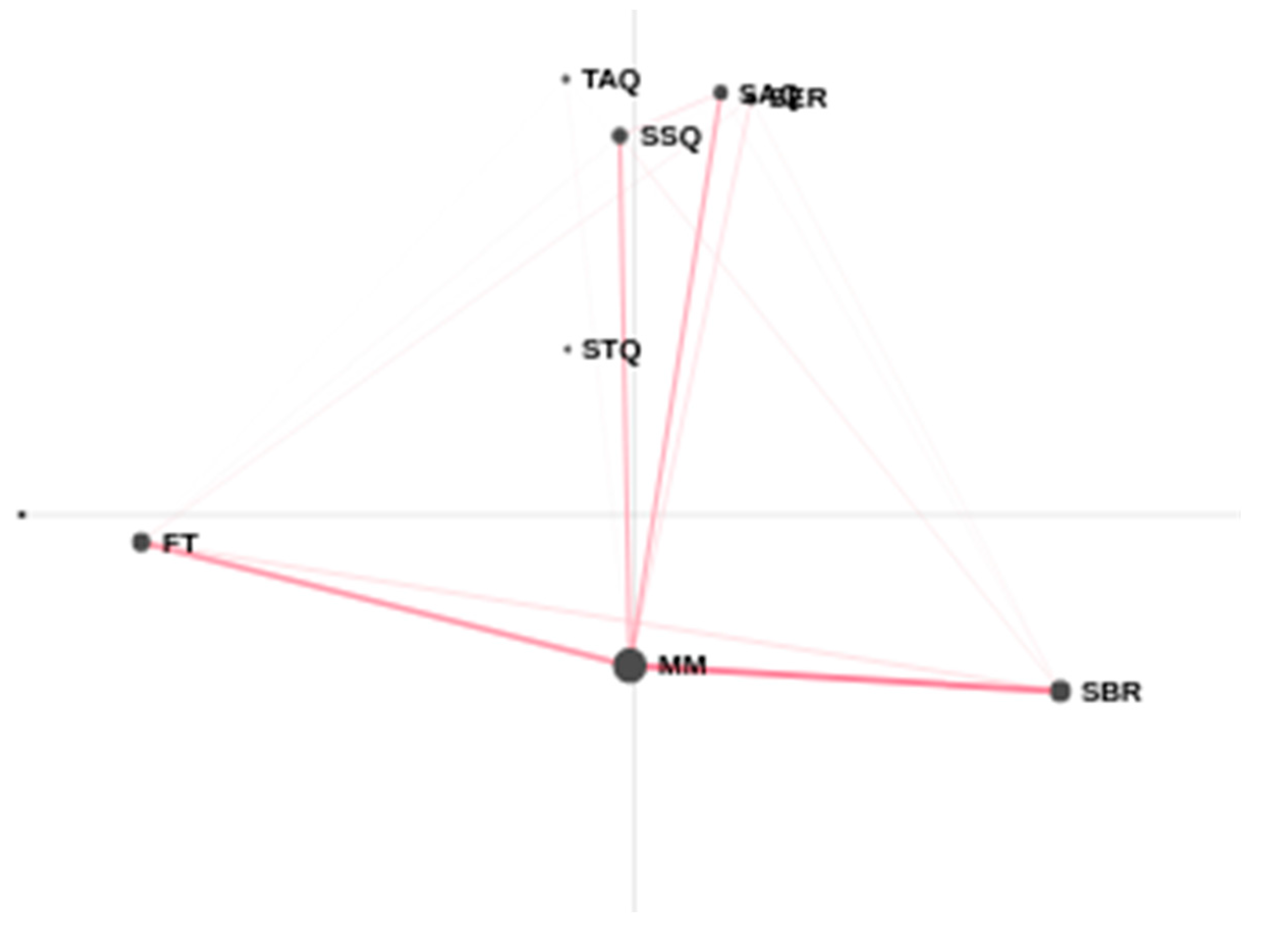
| Unit | Key Learning Activity | Arnab Taxonomy Components 1 |
|---|---|---|
| Software Takes Command | Read/Respond | Highly directed progressions (lower autonomy) |
| Code is Poetry | Learning Logs | Highly directed progressions (lower autonomy) Discovery (higher autonomy) |
| Break It to Make It | Robot Coding
| Collaboration, communal discovery, and strategy/planning (higher autonomy) |
| Putting it All Together | Final portfolio and reflection | Collaboration, communal discovery, and strategy/planning (higher autonomy) |
| Code | Description | Example |
|---|---|---|
| MM | Making Meaning—Student posts work | “Here is my final reflection for the course” |
| FT | Feedback from teacher—Teacher provides feedback on student work | “This is very insightful.” |
| SBR | Student response (brief) to another student | “Thank you for allowing me to open up my understanding about computer science and why it is needed.” |
| SER | Student Extended Response—student offers substantive response to another student’s post | “I agree that this stuff can be tough. I seem to get caught up trying to adjust one minor detail for an hour at a time. It would be cool if you could have a slider to adjust the power of the throw, or one that adjusted the equation for gravitational pull. (you might be able to find something like this that someone else has already built).” |
| STQ | Student asks teacher a question | “What is the best way to share content with the group?” |
| SSQ | Student asks student a question | “What courses do you currently teach at the high school level? How was your second year of teaching going compared to your first?” |
| TAQ | Teacher answers question | “Sharing your work via a blog post is fine.” |
| SAQ | Student answers student question | “You can use QuickTime to record a screencast of your Etoys project and then upload it to something like YouTube” |
| Key Learning Activity | # Student Posts | % Student Posts | # Instructor Posts | % Instructor Posts | Total Posts |
|---|---|---|---|---|---|
| Learning Log | 46 | 79% | 12 | 21% | 58 |
| Read/Respond | 130 | 87% | 20 | 13% | 150 |
| Reflection | 14 | 50% | 14 | 50% | 28 |
| Robot Coding | 151 | 86% | 24 | 14% | 175 |
| Totals | 341 | 83% | 70 | 17% | 411 |
| Key Learning Activity | # MM | # TF | # TAQ | # STQ | # SAQ | # SSQ | # SBR | # SER | Total |
|---|---|---|---|---|---|---|---|---|---|
| Learning Log | 31 | 12 | 0 | 2 | 0 | 2 | 12 | 2 | 61 |
| Read/Respond | 96 | 19 | 0 | 0 | 0 | 1 | 29 | 5 | 150 |
| Reflection | 13 | 14 | 0 | 0 | 0 | 0 | 1 | 8 | 28 |
| Robot Coding | 77 | 18 | 1 | 0 | 16 | 20 | 36 | 10 | 178 |
| Totals | 217 | 63 | 1 | 2 | 16 | 23 | 73 | 17 | 417 |
Publisher’s Note: MDPI stays neutral with regard to jurisdictional claims in published maps and institutional affiliations. |
© 2021 by the authors. Licensee MDPI, Basel, Switzerland. This article is an open access article distributed under the terms and conditions of the Creative Commons Attribution (CC BY) license (https://creativecommons.org/licenses/by/4.0/).
Share and Cite
Ardito, G.; Czerkawski, B. The Development of Autonomous Student Learning Networks: Patterns of Interactions in an Open World Learning Environment for Teachers Exploring Teaching with and through Computer Science. Sustainability 2021, 13, 8696. https://doi.org/10.3390/su13168696
Ardito G, Czerkawski B. The Development of Autonomous Student Learning Networks: Patterns of Interactions in an Open World Learning Environment for Teachers Exploring Teaching with and through Computer Science. Sustainability. 2021; 13(16):8696. https://doi.org/10.3390/su13168696
Chicago/Turabian StyleArdito, Gerald, and Betül Czerkawski. 2021. "The Development of Autonomous Student Learning Networks: Patterns of Interactions in an Open World Learning Environment for Teachers Exploring Teaching with and through Computer Science" Sustainability 13, no. 16: 8696. https://doi.org/10.3390/su13168696
APA StyleArdito, G., & Czerkawski, B. (2021). The Development of Autonomous Student Learning Networks: Patterns of Interactions in an Open World Learning Environment for Teachers Exploring Teaching with and through Computer Science. Sustainability, 13(16), 8696. https://doi.org/10.3390/su13168696






